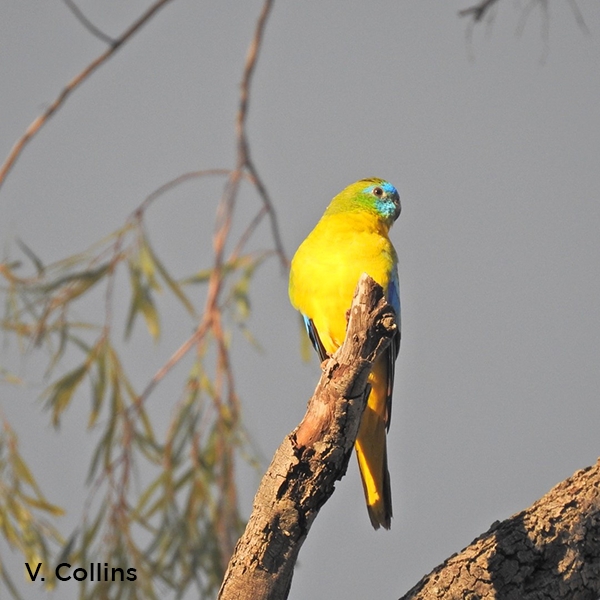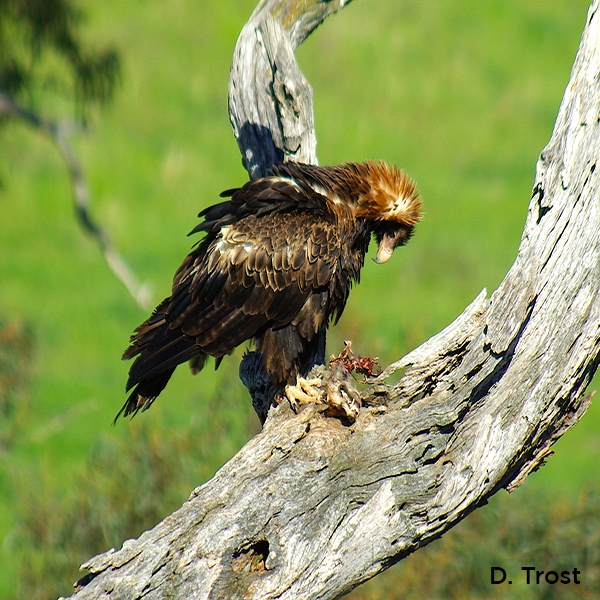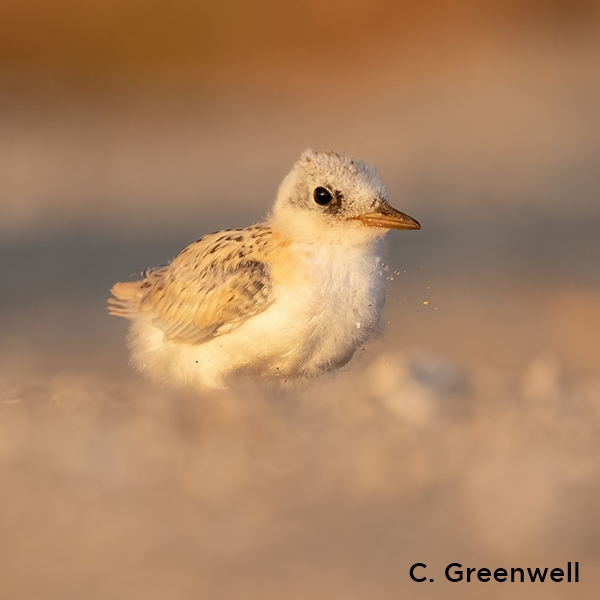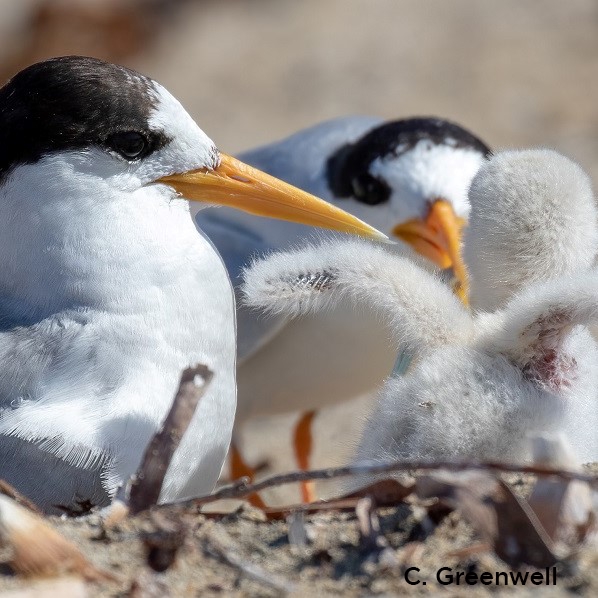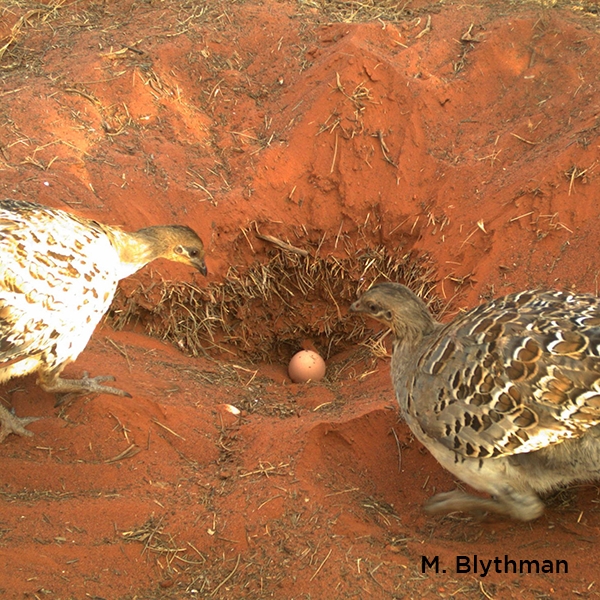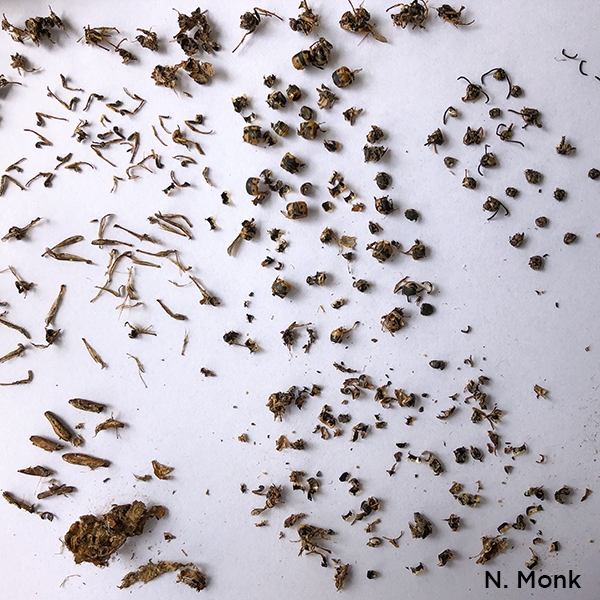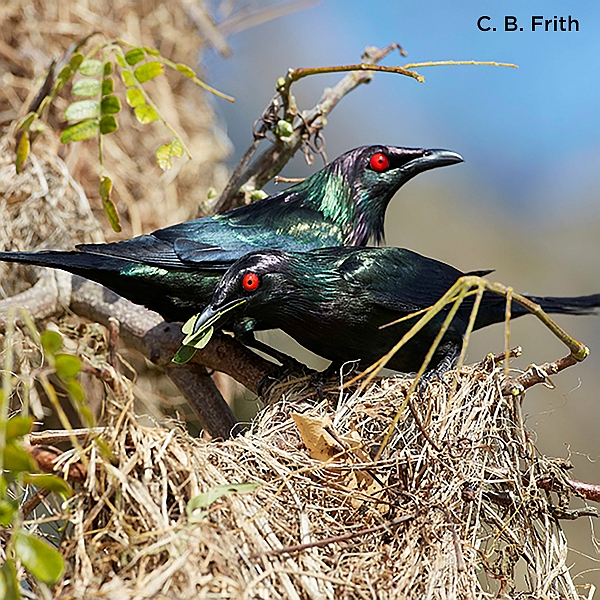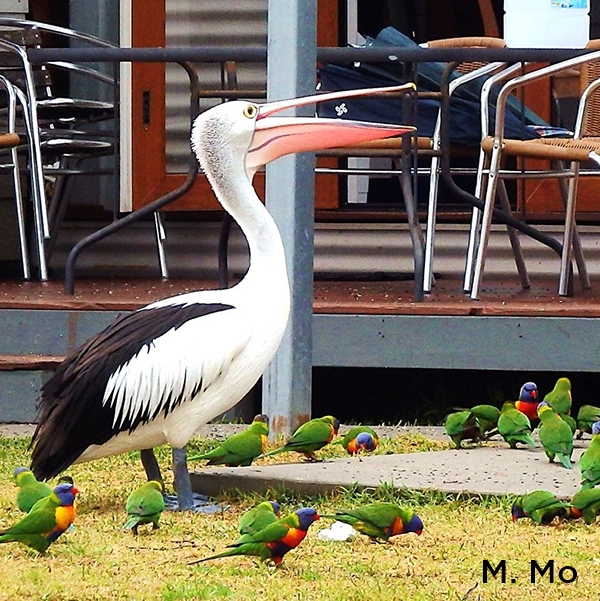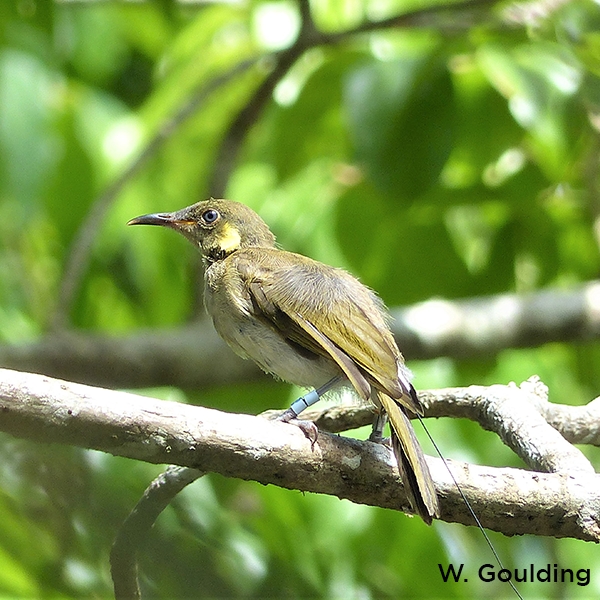Winter avifauna of Wanjarri Nature Reserve and Lake Mason Conservation Park of the Eastern Goldfields, Western Australia
David T. Bell, Roma C. Bell, William A. Loneragan
pp. 198-205
Abstract
Surveys of the avifauna of Wanjarri Nature Reserve and Lake Mason Conservation Park during late July 2015 recorded 100 species, with 68 at Wanjarri and 90 at Lake Mason. The greater number of species at Lake Mason Conservation Park was attributed to the presence of 19 species of waterbirds associated with the lake. Although nearly equal numbers of terrestrial species were found at both reserves, the frequency of occurrence records from Lake Mason showed significantly greater frequencies for several species, probably because of the greater availability of surface water there. The significantly higher frequencies of Horsfield’s Bronze-Cuckoo Chalcites basalis and Pallid Cuckoo Cacomantis pallidus at Wanjarri Nature Reserve may have been related to the many hairy caterpillars available there as a food resource. Detrended Correspondence Analysis showed that the major assemblages of bird species were associated primarily with vegetation type and secondarily with the geographic separation of the two reserves. Species associated with Mulga Acacia aneura woodlands, spinifex Triodia grasslands and saltbush Atriplex habitats on Wanjarri and Lake Mason were similar to those recorded in other arid-zone habitats of Western Australia. Species associated with Mulga woodlands included Crested Pigeon Ocyphaps lophotes, Slaty-backed Acanthiza robustirostris, Chestnut-rumped A uropygialis and Inland Thornbills A. apicalis, Singing Lichenostomus virescens and Spiny-cheeked Honeyeaters Acanthagenys rufogularis, Rufous Whistler Pachycephala rufiventris and Red-capped Robin Petroica goodenovii. Species associated more often with spinifex grasslands and saltbush habitats were White-winged Malurus leucopterus and Variegated Fairy-wrens M. lamberti, Australian Magpie Cracticus tibicen, Brown Songlark Cincloramphus cruralis, and several raptors. Inclusion of these two reserves in the conservation estate of Western Australia is important as they are at the margin of the distribution ranges for several species. Data from our surveys will facilitate future assessment of populations of birds and assist in management decisions regarding future protection of the avifauna in these reserves.
References
Barrett, G., Silcocks, A., Barry, S., Cunningham, R. & Poulter, R. (2003). The New Atlas of Australian Birds. Royal Australasian Ornithologists Union, Melbourne.
Beard, J.S. (1990). Plant Life of Western Australia. Kangaroo Press, Kenhurst, NSW.
Bell, D.T., Agar, P.K., Luyer, R.H. & Loneragan, W.A. (2015). Winter bird assemblages at Lorna Glen (Matuwa) and Earaheedy (Kurarra Kurarra), two former pastoral leases of Wiluna Shire, Western Australia. Amytornis 7, 1-14.
Bell, D.T., Agar, P.K., Luyer, J.R. & Robertson, H.M. (2014a). Winter bird assemblages of the Fortescue Marshes and surrounding vegetation, Pilbara Region, Western Australia. Amytornis 6, 1–18.
Bell, D.T., Agar, P.K., Paull, A.K. & Williams, M.R. (2014b). Mulga woodland bird assemblages of Thundelarra and Lakeside, two former pastoral leases of the Murchison Region, Western Australia. Amytornis 6, 19–33.
Bell, D.T., Bell, R.C. & Cousin, J.A. (2010). Winter foraging patterns in the avifauna from south-west Western Australia with special reference to niche differentiation in the Acanthizidae and Meliphagidae. Amytornis 2, 1–14.
Bell, D.T., Bell, R.C. & Loneragan, W.A. (2007). Winter bird assemblages and foraging patterns across an aridity gradient in south-west Western Australia. Journal of the Royal Society of Western Australia 90, 219–227.
Bell, D.T., Bell, R.C. & Loneragan, W.A. (2013a). Avifauna of the Mulga-Eucalypt Line in Western Australia. Journal of the Royal Society of Western Australia 96, 41–53.
Bell, D.T., Luyer, J.R. & Agar, P.K. (2013b). Birds of the Doolgunna and Mooloogool Rangelands, northeast Gascoyne Region, Western Australia. Amytornis 5, 1–13.
Burbidge, A.A. & Fuller, P.J. (2007). Gibson Desert birds: Responses to drought and plenty. Emu 107, 126–134.
Burbidge, A.H., Johnstone, R.E., Fuller, P.J. & Stone, P. (2000). Terrestrial birds of the southern Carnarvon Basin, Western Australia: Contemporary patterns of occurrence. Records of the Western Australian Museum, Supplement 61, 449–464.
Burbidge, A.H., Johnstone, R.E. & Pearson, D.J. (2010). Birds in a vast arid upland: Avian biogeographical patterns in the Pilbara region of Western Australia. Records of the Western Australian Museum, Supplement 78, 247–270.
Burnie, D. & Andrews, D. (2013). Birds of Australia. Dorling Kindersley, Melbourne.
Christidis L. & Boles, L. (2008). Systematics and Taxonomy of Australian Birds. CSIRO Publishing, Melbourne.
Cody, M.L. (1994). Mulga bird communities. 1. Species composition and predictability across Australia. Australian Journal of Ecology 19, 206–219.
Craig, M.D. & Chapman, A. (2003). Effects of short-term drought on the avifauna of Wanjarri Nature Reserve: What do they tell us about drought refugia? Journal of the Royal Society of Western Australia 86, 133–137.
Department of Conservation and Land Management (1996). Wanjarri Nature Reserve Management Plan 1996-2006. Management Plan No. 35, Department of Conservation & Land Management for the National Parks & Nature Conservation Authority, Perth.
Frith, D.W. (1984). Foraging ecology of birds in an upland tropical rainforest in North Queensland. Australian Wildlife Research 11, 325–347.
Hall, N.J. & Milewski, A.V. (1994a). The biological survey of the Eastern Goldfields of Western Australia. Introduction. Records of the Western Australian Museum Supplement 47, 1–8.
Hall, N.J. & Milewski, A.V. (1994b). The biological survey of the Eastern Goldfields of Western Australia. Physical environment. Records of the Western Australian Museum Supplement 47, 9–23.
Johnstone, R.E. & Storr, G.M. (1998). Handbook of Western Australian Birds, Volume 1: Non-Passerines. Western Australian Museum, Perth.
Johnstone, R.E. & Storr, G.M. (2004). Handbook of Western Australian Birds, Volume 2: Passerines. Western Australian Museum, Perth.
Jongman, J.H.G., ter Braak, C.J.F. & Tongeren, O.F.R. (Eds) (1995). Data Analysis in Community and Landscape Ecology. Cambridge University Press, Cambridge, U.K.
Keighery, G.J., Hall, N.J. & Milewski, A.V. (1994). The biological survey of the Eastern Goldfields of Western Australia. Vegetation and flora. Records of the Western Australian Museum Supplement 47, 24–50.
Lindenmayer, D.B., Burns, E.L., Tennant, P., Dickman, C.R., Green, P.T., Keith, D.A., Metcalfe, D.J., Russell-Smith, J., Wardle, G.M., Williams, D., Bossard, K., deLacey, C., Hanigan, I., Bull, C.M., Gillespie, G., Hobbs, R.J., Krebs, C.J., Likens, G.E., Porter, & Vardon, M. (2015). Contemplating the future: Acting now on long-term monitoring to answer 2050’s questions. Austral Ecology 40, 213–224.
Lindenmayer, D.B., Likens, G.E., Andersen, A., Bowman, D., Bull, M.C., Burns, E., Dickman, C.R., Hoffman, A., Keith, D.A., Liddell, M.J., Lowe, A.J., Metcalfe, D.J., Phinn, S.R., Russell-Smith, J., Thurgate, N. & Wardle, G.M. (2012). Value of longterm ecological studies. Austral Ecology 37, 745–757.
Lindenmayer, D.B., Wood, J.T. & MacGregor, C. (2009). Do observer differences in bird detection affect inferences from large-scale ecological studies? Emu 109, 100–106.
McKenzie, N.L., Rolfe, J.K. & Youngson, W.K. (1994). The biological survey of the Eastern Goldfields of Western Australia. Physical environment. Records of the Western Australian Museum Supplement 47, 51–85.
Morcombe, M. (2000). Field Guide to Australian Birds. Steve Parish Publishers, Brisbane.
Moriarty, T.K. (1972). Birds of Wanjarri, WA. (27°25’S, 120°40’E). Emu 72, 1–7.
Recher, H.F. & Davis, W.E. Jr (1997). Observations on the foraging ecology of a mulga bird community. Wildlife Research 24, 27–43.
Recher, H.F. & Davis W.E. (2002). Foraging profile of a Salmon Gum woodland avifauna in Western Australia. Journal of the Royal Society of Western Australia 85, 103–111.
Recher, H.F. & Davis, W.E. (2010). The foraging behaviour of woodland birds along the mulga-eucalypt line on Mt. Gibson Station, Western Australia during late winter and spring. Amytornis 2, 29–41.
Saunders, D.A. & Ingham, J. (1995). Birds of Southwestern Australia. An Atlas of Changes in the Distribution and Abundances of the Wheatbelt Avifauna. Surrey Beatty & Sons, Chipping Norton, NSW.
Senior, S.L. (1995). Sandstone: From Gold to Wool and Back Again: A District History. Shire of Sandstone, Sandstone, WA.
Storr, G.M. (1985). Birds of the mid-eastern interior of Western Australia. Records of the Western Australian Museum Supplement 22, 1–45.
Systat Software Inc. (2006). SigmaStat 3.5 for Windows User’s Manual. Systat Software Inc., Chicago, Illinois.
Tulloch, A.I.T. & Szebo, J.K. (2012). A behavioural ecology approach to understand volunteer surveying for citizen science datasets. Emu 112, 313–325.



